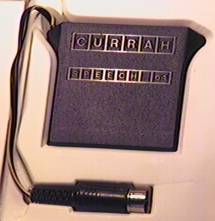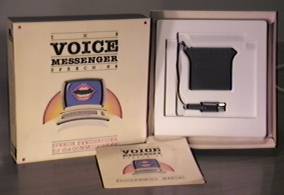Voice Messenger - Speech 64
 |
This is one of many speech synthesizer cartridges for the Commodore 64
(others were the COMvoice, the Magic Voice, the ProVoice, the Voice Master,
etc.). This one seems to have arrived on the market in 1984, and it is
incompatible with Commodore's Magic Voice, meaning that it is probably
completely unsupported by software. But let's face it, in those days that
didn't matter so much, because most personal computer owners could at least
program in BASIC. |
Unlike some other speech synthesizers of the day, the Voice Messenger didn't
have a pre-set vocabulary. It could translate any text into speech, and the
programmer could specify the sounds using what the Voice Messenger's manual
calls "allophones", which seem to be roughly equivalent to the
"phonemes" of the Amiga's narrator.
The Voice Messenger adds commands to Commodore BASIC, so that BASIC
programmers can easily use the unit. The BASIC commands are:
| Command | Function |
| INIT |
Initializes the voice unit. After INIT is executed, a copyright message
appears on the screen, and the Voice Messenger will say the name of any letter
or symbol that is hit on the keyboard. (Graphics symbols are merely voiced as
"graphic".) The Voice Messenger uses the higher pitched voice by
default. |
| KON [0|1] |
KON turns on the voicing of keys on the keyboard. KON 0 will make it use
the low voice, KON 1 will make it use the high voice. The default is 1. |
| KOFF | Turns off the voicing for keypresses. |
| SAY [0|1] "string" |
Makes the Voice Messenger voice the string in voice 0 (low) or voice 1
(high). |
| BYE |
Suspends Voice Messenger operation. BASIC will go back to normal until
INIT is invoked again. |
The Voice Messenger has an allophone buffer, which can contain up to 256
allophones. The BASIC variable SP% reports how much space is left in the
allophone buffer, so that the programmer can avoid buffer overflow. This is
necessary because the BASIC program continues to execute as the voice
syntesizer works. Multiple SAY commands in a row can easily fill the
buffer. Nothing bad happens, but words that don't fit in the buffer are
never spoken.
There is also support for intonation, but this only works if the Voice
Messenger is given allophones instead of normal text. Allophones entered as
capital letters are intoned UP, and allophones entered as lowercase letters
are not intoned.
The manual includes instructions and sample code for using the Voice
Messenger in assembly language (machine code). In machine code, allophones
are programmed using numeric codes according to these tables (note that there
are no allophones for the letters x or q):
Allophone
(BASIC string mnemonic) | Hex Code | Sounds Like |
| (aa)/(ay) | 14 | 'ay' in hay |
| (ee) | 13 | 'ee' in see |
| (ii) | 06 | 'i' in hive |
| (oo)/(eau) | 35 | 'o' in stove |
| (bb) | 3F | 'b' in bat |
| (dd) | 21 | 'd' in do |
| (gg) | 3D | 'g' in got |
| (ggg) | 22 | 'g' in big |
| (hh) | 39 | 'h' in hoe |
| (ll) | 3E | 'l' in let |
| (nn) | 38 | 'n' in no |
| (rr) | 0E | 'r' in ruin |
| (tt) | 0D | 't' in to |
| (yy) | 19 | 'y' in yeah |
| (ar) | 3B | 'ar' in arm |
| (aer) | 2F | 'air' in repair |
| (ch) | 32 | 'ch' in church |
| (ck) | 29 | 'ck' in clock |
| (ear) | 3C | 'ear' in clear |
| (eh) | 1A | 'ar' in wary |
| (er) | 33 | 'er' in leader |
| (err) | 34 | 'ur' in purr |
| (ng) | 2C | 'ng' in tongue |
| (or) | 3A | 'or' in sore |
| (ou) | 16 | 'oo' in root |
| (ouu) | 1F | 'oo' in food |
| (ow) | 20 | 'ow' in now |
| (oy) | 05 | 'oy' in boy |
| (sh) | 25 | 'sh' in ship |
| (th) | 1D | 'th' in thin |
| (dth) | 12 | 'th' in then |
| (uh) | 1E | 'oo' in took |
| (wh) | 30 | 'wh' in which |
| (zh) | 26 | 'z' in azure |
|
Allophone
(BASIC string mnemonic) | Hex Code | Sounds Like |
| a | 18 | phonetic |
| b | 1C | phonetic |
| c | 08 | phonetic |
| d | 15 | phonetic |
| e | 07 | phonetic |
| f | 28 | phonetic |
| g | 24 | phonetic |
| h | 1B | phonetic |
| i | 0C | phonetic |
| j | 0A | phonetic |
| k | 2A | phonetic |
| l | 2D | phonetic |
| m | 10 | phonetic |
| n | 0B | phonetic |
| o | 17 | phonetic |
| p | 09 | phonetic |
| r | 27 | phonetic |
| s | 37 | phonetic |
| t | 11 | phonetic |
| u | 0F | phonetic |
| v | 23 | phonetic |
| w | 2E | phonetic |
| y | 31 | phonetic |
| z | 2B | phonetic |
Allophone
(BASIC string mnemonic) | Hex Code | Sounds Like |
| (apostrophe) | 01 | very short pause |
| (space) | 03 | pause between words |
| (comma) | 04 | pause between phrases |
| (period) | hybrid of 04+04 | pause between sentences |
(Compiled from two tables in The Voice Messenger Speech 64 Programming Manual)
|
Note that there are less than 64 allophones. It takes only six bits to
define this number (bits 0 to 5). Bit 6 is for the voice (0 = low voice), and
bit 7 is for intonation (1 = intonate up).
Here is the sample ASM code, reproduced from section 6 of manual:
Initializing Speech Unit
(Not needed when accessing speech
chip directly) |
INIT SEI ;disable interrupts
LDA $A7F0 ;select Voice Messenger ROM
JSR $A121 ;call set up routine
LDA $A7F0 ;disable Voice Messenger ROM
CLI ;enable interrupts
* LDA $02BE
* ORA #$20
* STA $02BE
RTS
(* These three lines turn the Voice Messenger BASIC commands on,
but can be omitted if Voice Messenger is not going to be used from BASIC.)
Set bit 1 of $02BE to turn keyvoices off. (LDA $02BE, ORA #$02, STA $02BE)
Bit 3 of $02BE determines which voice is used.
|
| Using the Speech Buffer |
JSR INIT ;call initialization routine
LDY #$00
WAIT LDX $CE5F ;is buffer full?
DEX
BEQ WAIT ;wait if so
LDA DATA,Y ;else get allophone
BEQ FINISH ;exit if finished
LDX $CE64
STA $CF00,X ;store allophone in buffer
INC $CE64 ;and update pointer
INY ;next allophone
JMP WAIT
FINISH RTS
DATA DB $5B,$C7,$7E,$75 ;the four data bytes
DB 0 ;end marker
|
| Using Text to Speech Conversion |
JSR INIT ;call initialization routine
LDA $02BE
AND #$FE
STA $02BE ;select low voice
NEXT LDA DATA,X ;get character
STA $CE70,X ;and store it in buffer
BEQ FINISH ;if last char (null byte)
INX
JMP NEXT
FINISH INC $CE63 ;start conversion
RTS
DATA DB 'THIS IS A DEMONSTRATION OF TEXT TO SPEECH CONVERSION'
DB 0
|
| Using the Speech Chip Directly |
LDA #$0F
STA $D418 ;set sound to maximum
LDX #$00
STATUS LDA $DE00 ;is speech chip ready?
BPL STATUS ;wait if not
LDA DATA,X ;else get allophone
STA $DE01 ;and send to low voice
BEQ FINISH ;end if last allophone
INX
JMP STATUS ;get next one
FINISH RTS
DATA DB $1B,$87,$3E,$35
DB 0 ;end of data
|
One very interesting feature of the Voice Messenger is that the supplied
cabling actually feeds the speech synthesizer's output into the C64's audio
input. This should allow the C64 to modulate the voice.
| Sample | Description |
| 1 |
The alphabet, as said from the SAY command.
SAY "A B C D E F G H I J K L M N O P Q R S T U V W X Y Z" |
| 2 |
Some characters are pronounced differently when KON is in effect and
a key is pressed. This is what the Voice Messenger says for the 'Z' key.
|
| 3 |
Numbers, as said from the SAY command.
SAY "1 2 3 4 5 6 7 8 9 0" |
| 4 |
Another different pronunciation from a keypress. The Voice Messenger
was made in the U.K., so I wonder if the plant was on the River Severn? :-)
|
| 5 |
The result of:
SAY 0 "VOICE MESSENGER SPEECH SIXTY 4"
(low voice) |
| 6 |
The result of:
SAY 1 "VOICE MESSENGER SPEECH SIXTY 4"
(high voice) |
| 7 |
At first I thought, by dim memory, that the low voice sounded similar
to a Cylon Centurion from Battlestar Galactica. It doesn't.
SAY 0 "BY YOUR COMMAND" |
| 8 |
It's possible to make interesting noises just by playing with
intonation.
SAY "[aaAAaaaaAA]" |
| 9 |
This sounds like a helicopter. Or maybe a sewing machine. :-)
SAY 0 "hhhhhh" |
| 10 |
A real test of the Text to Speech routine:
SAY "HROTHGARS COOL OLD JUNK PAGE"
It didn't do too well, but even I can't pronounce 'Hrothgar' as spoken by the
author of Beowulf. |
This interesting device, in its original box and with manual and
cabling, was donated to my collection by Frank McCormick, CoSysop and
programmer of McBBS, one of the best BBSes in the city of Montreal from
1987 to 2000. Thanks Frank! |
 |
[Hrothgar's Cool Old Junk Page]
2007-07-21